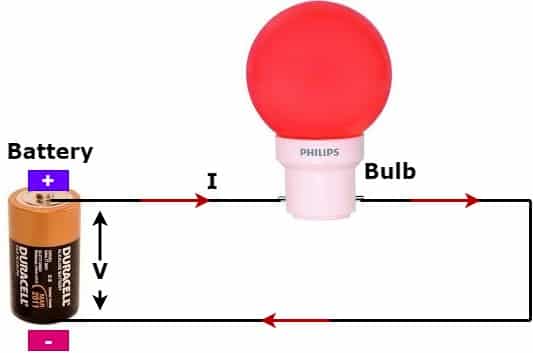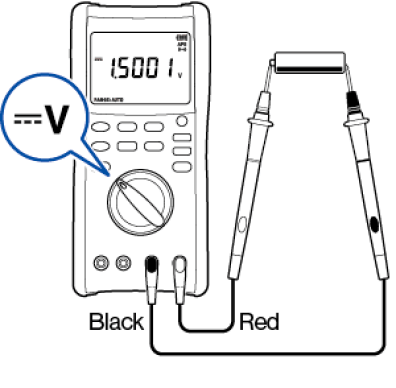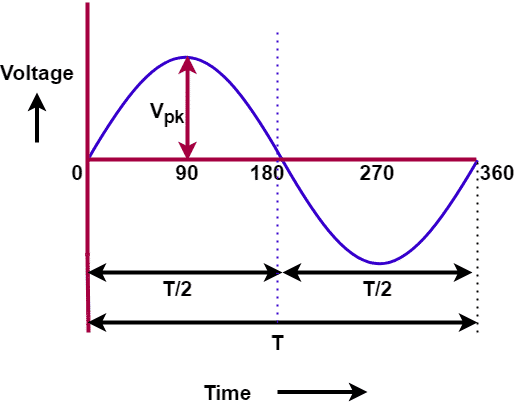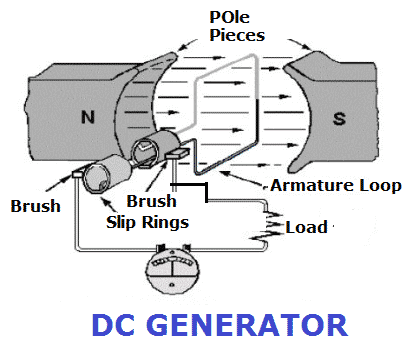Definition of VoltageThe electrical force that would propel an electric current between two places is referred to as voltage. Voltage specifically is the same as energy per charge. In static electric fields, the electrical potential difference between any two places is equal to the voltage between them. The phrases are no longer interchangeable in the broader context of temporal variations in electric and magnetic fields. The pressure that an electrical circuit is subjected to from a power source is known as voltage. Also, as a result of the pressure, the charge electrons are forced through a conducting loop. In an electrical circuit, the current is created by the motion of electrons. Because of this, when there is voltage present, the current does the work. The circuit schematic below illustrates the electron flow when voltage is applied. 
Electric potential is the force needed to direct a unit electric charge in a static electric field. A voltmeter can measure voltage. The volt is the measurement's base unit. A path's voltage is calculated by dividing the total energy needed to convey a small electric charge along it by the size of the charge. This is mathematically represented as the time rate of change of the magnetic field along that path and the line integral of the electric field. In the general case, the voltage between two points must take into account both a static (constant) electric field and a dynamic (changing over time) electromagnetic field. HistoryHistorically, voltage has also been referred to as "stress" and "pressure." The term "High Tension" (HT), which is frequently used in thermionic valve (vacuum tube) based electronics, is an example of how tension is still utilised even if pressure is no longer relevant. Hydraulic analogyWater flowing through a closed circuit of pipework that is powered by a mechanical pump is a straightforward analogue for an electric circuit. A water circuit can be used to describe this. The difference in voltage between the two places is equivalent to the variation in water pressure. When there is a differential in water pressure between two points, water flow (caused by the pump) from the first point to the second can be used to drive a turbine, for example. Similar to this, electric current driven by a voltage differential caused by an electric battery can perform work. For instance, the starter motor in a vehicle can be driven by the current produced by an automotive battery. Pressure is absent if the pump isn't operating. This water flow analogy is helpful in comprehending a number of electrical principles. In such a system, the labour required to move water is equal to the pressure times the volume of water carried. Similar to this, in an electrical circuit, the labour required to transfer electrons or other charge carriers is equal to "electrical pressure," an archaic term for voltage, times the amount of electrical charge carried. Voltage is an easy technique to gauge a person's capacity for labour. In terms of "flow," the higher the "pressure difference" between two places (such as a difference in voltage or water pressure), the greater the flow will be between them (either electric current or water flow). ApplicationsNow that it is again being used commonly, "voltage" refers to "voltage difference." One must be aware of the two points between which the voltage is stated or measured when using the term "voltage" in the abbreviated sense. A voltmeter's electrical leads need to be attached to the first and second points, respectively, in order to measure voltage difference. The voltage between the two stated pointsDefining the number of volts dropped over an electrical device is a typical application of the word "voltage" (such as a resistor). The "voltage" in this instance, or more precisely, the "voltage drop across the device," can be helpfully interpreted as the variance of two readings. One electrical lead from the voltmeter is connected to the device's first terminal for the initial measurement, and the other lead is connected to the ground. The second measurement is similar, but it is made with the first voltmeter lead connected to the gadget's second terminal. The variation between the two readings is known as the voltage drop. Using a voltmeter that is separated from the ground, it is possible to directly and safely measure the voltage drop across a device. Addition of voltagesAn "ideal conductor," or a conductor without resistance and not surrounded by a shifting magnetic field, connects two points in an electric circuit so that the voltage difference between them is zero. There may be additional pairs of sites with a zero voltage differential, though. No current will flow via the connection if two such sites are connected by a conductor. Voltages between A and B and B and C are added to get the voltage between A and C. Kirchhoff's circuit principles can be used to calculate the various circuit voltages. There is a distinction between instantaneous and average voltage when discussing alternating current (AC). Direct current (DC) and alternating current (AC) can add instantaneously, but average voltages can only be usefully added when they apply to signals that all have the same frequency and phase. Measuring InstrumentsThe voltmeter, potentiometer, and oscilloscope are tools used to measure voltage variations. According to Ohm's Law, the current flowing through a fixed resistor, which the voltmeter uses to measure voltage, is proportional to the voltage difference across the resistor. In a bridge circuit, the potentiometer balances the unknown voltage against a known voltage to function. The voltage difference is amplified by the cathode-ray oscilloscope and used to divert an electron beam from its intended course, with the deflection of the beam being proportional to the voltage difference. The most important factor for diagnosing electrical and electronic circuit problems is the circuit's voltage. We can measure the voltage in a number of ways. Digital or analogue multimeters are both acceptable. A multimeter is commonly used to measure voltage. After connecting the positive and negative test leads, decide on the voltage measurement range. When using an analogue metre to measure, the highest measuring range should be chosen. Reduce the meter's range if it doesn't respond. Once the voltage is inside the measuring range, keep reducing the range. 
Types of voltageThere are two types of voltage:
Alternating Current-voltage (AC)Alternating current is the sort of electricity that is delivered to houses around the globe. Alternating current is the best choice for this application since it can travel across vast distances. The current in an AC circuit travels over wires in two directions and oscillates back and forth. Appliances can still be powered since electrical energy only ever goes in one direction. The voltage between any two places in the circuit is continually changing since the current's direction and the quantity of energy supplied to each component of the circuit must both be changing. The sinusoidal time variation of the AC voltage. The waveform of AC voltage is given below: 
Direct Current-voltage (DC)A DC circuit is one in which the flow of current is only in one direction. A normal battery has two terminals, one positive and one negative, and can only push charge in one direction across a circuit. The electromotive force (emf) for DC circuits can therefore be supplied by batteries. A DC circuit with a fixed resistance will experience constant current flow. As a result, both the work performed per unit charge and the energy transmitted to the resistor will remain constant. 
Next TopicDemocracy Definition
|
 For Videos Join Our Youtube Channel: Join Now
For Videos Join Our Youtube Channel: Join Now
Feedback
- Send your Feedback to [email protected]
Help Others, Please Share









